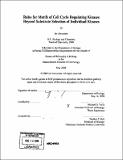Roles for motifs of cell cycle regulating kinases beyond substrate selection of individual kinases
Author(s)
Alexander, Jes
DownloadFull printable version (24.71Mb)
Other Contributors
Massachusetts Institute of Technology. Dept. of Biology.
Advisor
Michael B. Yaffe.
Terms of use
Metadata
Show full item recordAbstract
Errors in the cell cycle, particularly during mitosis, have recently been implicated in tumorigenesis and cancer formation. Several protein kinases, including the major mitotic kinases Cdkl, Aurora A, Aurora B, Nek2, and Plkl, and the Polo-like kinase (Plk) family, Plkl, Plk2, Plk3, and Plk4, are known to play important roles in the regulation of mitosis and other phases of the cell cycle to prevent such errors. However, the mechanisms underlying many of the roles of these kinases are unknown because the appropriate substrates have not been identified. To aid in substrate identification and to gain insight into the role of substrate specificity in the regulation of these kinases, we have determined the motifs of the major mitotic kinases and the Plk family of kinases by Positional Scanning Oriented Peptide Library Screening (PS-OPLS), which gives complete, unbiased motifs. The PS-OPLS motif of Plkl revealed a previously unreported specificity of Plkl leading to the identification of new candidate substrates, including p31/Comet, which is involved in the silencing of the spindle assembly checkpoint for anaphase onset. Additionally, the motifs and the localizations of the major mitotic kinases lead us to put forward a model potentially explaining how the major mitotic kinases, despite having overlapping localizations and access to the same sites on substrates, phosphorylate distinct sites. This model, if true, would suggest that the motifs and localizations of all of the major mitotic kinases coordinately direct the group of kinases to the appropriate substrates. The motifs of the Plk family reveal that Plk2 and Plk3 phosphorylate sites previously primed by phosphorylation by a tyrosine kinase, suggesting that these kinases may integrate tyrosine kinase and serine/threonine kinase signaling in a novel way. (cont.) Finally, we find that Plk3 has a phosphorylation dependent toggle switch which changes the motif of the kinase. The result suggests that the motif of a kinase is not necessarily static, as was previously thought, and that the motif of certain kinases may be modulated for different roles. These results give us deeper insight into the function of kinases at the level of motifs, substrates, and the regulation of groups of kinases.
Description
Thesis (Ph. D.)--Massachusetts Institute of Technology, Dept. of Biology, 2008. Includes bibliographical references.
Date issued
2008Department
Massachusetts Institute of Technology. Department of BiologyPublisher
Massachusetts Institute of Technology
Keywords
Biology.